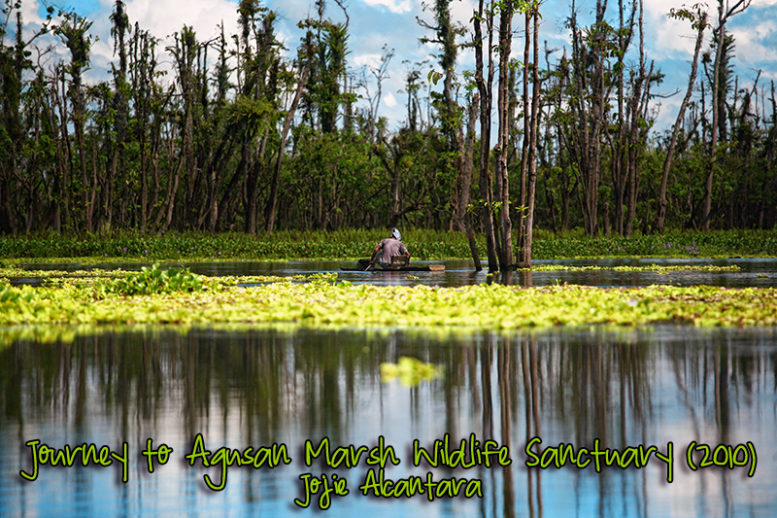The Agusan Marsh, located in the province of Agusan del Sur, Northeastern Mindanao, was declared a protected area by Presidential Proclamation no. 913 dated 31-October-1996. Total protected area is 19,196.56 hectares (14,835.99 hectares core zone; and 4,360.57 hectares buffer zone). Agusan Marsh controls the flooding in the Agusan River by sponging the high level of water, thus preventing flooding in the lower portions of the river.
Jonathan Mayuga, Business Mirror, 9-April-2016, “Unique Ecosystem,” commented: “During the wet season, Agusan Marsh is a large single swamp or a single lake. During the dry season it turns into a series of interconnected rivers and isolated swamps and lakes with Agusan River flowing through the Center. Eight river tributaries namely: Gibong, Simulao, Manat, Baobo, Logum, Ihaoan, Umayan, and Adgaoan drain into the Agusan Marsh.”
Agusan River also houses one-of-a-kind habitation like the sago and peat swamp forests. Jonathan Mayuga, Business Mirror, 6-April-2016, elaborated: “Agusan Marsh is known to have large peatlands, which are wetlands formed by plant fossils over thousands of years. They provide a host of important ecosystem services,” DENR Director Theresa Mundita-Lim, Biodiversity Management Bureau, said. “Peatland ecosystems are the most important carbon sink, more important than forests, due to its carbon-absorption capacity.”
During the heavy rains and floods, these peatlands can absorb huge volumes of water, preventing potentially destructive and deadly floods. “Peatlands are carbon storage. Destroying peatlands may release carbon into the atmosphere. It is important that these peatlands in the Agusan Marsh are preserved,” Director Lim said. Protected Area Superintendent, Agusan Marsh Wildlife Sanctuary (AMWS), Emmelie T. Ibonia, said “There are only two peatlands within the AMWS: the 5,325-hectare Campugan Peatland in San Francisco Town, and the 2,000-hectare Tala Goon Peatland in Talacogon Town. These peatlands are being protected along with important ecosystems and wildlife as part of our Biodiversity Monitoring Activities.”
Jonathan Mayuga further elaborated that the swamp forest is a source of fuelwood and exotic fruits like Kamandiis (Garcinia rubra), Lambug (Tambis) (Eugenia calubcub), wild Lanzones (Lancium domesticum), Durian (Durio zibethinus), and Marang (Rambutan) (Arthocarpus odoratissima).
The economic importance of the AMWS is highlighted during the summer months, when the dry areas of the Marsh are used to plant rice and corn. During the rainy season, Agusan Marsh is transformed into a big lake with fishermen casting their nets to catch Mudfish, Carp, Tilapia, Catfish, and Gourami. It is home to the fresh water soft shell Turtle (Trionyx) and the golden-crowned Flying Fox (Acerdon jubatus), both endangered.
112 species of flora and 127 species of fauna have made Agusan Marsh their home. Of 127 fauna species, 31 species are endemic, and 10 species are endangered. Water Hyacinths, Lotus, and Water Lilies abound. The critically endangered freshwater crocodile (Crocodylus mindorensis) and saltwater crocodile (Crocodylus porosus) are present in Agusan Marsh. “Lolong,” once the world’s largest 22-foot saltwater crocodile, was taken into captivity after being captured in the Marsh in 2011. AMWS was declared a Ramsar Wetland Site, and was awarded a certificate of recognition on 12-November-1999 for being a haven for food and shelter of foreign migratory wild birds seeking temporary shelter from the cold winter months of Siberia, Russia, China, and Japan.
A small group of ethnic Manobo tribal families have made their permanent homes deep within the Marsh living on floating homes made of bamboo and nipa lashed to hardwood logs that rise or fall with the level of the Marsh. The Marsh provides for the Manobos’ basic needs, except safe potable water.
Former President Fidel V. Ramos declared Agusan Marsh a wildlife sanctuary in 1996. Let us support the long-time efforts of DENR to establish an ecotourism package to deter illegal fishing and timber poaching. The ecotourism package features tourist-oriented activities like bird and crocodile watching, kayaking, or simply appreciating the marshland’s beautiful and colorful flora and fauna of which many are now endangered species.
